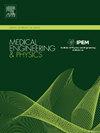评估利用脚踝加速度计测量步速的有限状态机算法:不同步速、任务和个人行走能力下的性能表现
IF 1.7
4区 医学
Q3 ENGINEERING, BIOMEDICAL
引用次数: 0
摘要
在临床和自由生活环境中,包括加速度计在内的可穿戴传感器是一种广为接受的步态评估工具。识别步态周期的阶段和子阶段的方法是全面评估病态步态所必需的。目前的研究评估了有限状态机(FSM)算法的准确性,该算法通过识别踝戴式加速度计的步态周期子阶段来检测步幅。该算法的性能在一系列速度(0.4-2.6 米/秒)、任务条件(如单任务和双任务步行)和个体特征中受到了挑战。具体来说,研究包括年轻成年人的一系列跑步机速度和患有神经系统疾病的老年人的地面行走条件。使用误差分析和布兰-阿尔特曼图对加速度数据中手动计数和算法衍生的步幅检测进行了评估。总体而言,该算法在不同步速范围和任务中成功检测到了年轻人和老年人的步幅(准确率达 96%)。FSM 算法的准确性与踝戴式加速度计相结合,提供了一种分析方法,它具有经济实惠、便于携带的工具,可以不受环境限制地对步态进行全面评估,并证明在以步态多变为特征的步行任务中表现良好。这些算法的功能和进步对于在临床和自由生活评估中识别相位依赖步态障碍至关重要。本文章由计算机程序翻译,如有差异,请以英文原文为准。
Evaluation of a finite state machine algorithm to measure stepping with ankle accelerometry: Performance across a range of gait speeds, tasks, and individual walking ability
Wearable sensors, including accelerometers, are a widely accepted tool to assess gait in clinical and free-living environments. Methods to identify phases and subphases of the gait cycle are necessary for comprehensive assessment of pathological gait. The current study evaluated the accuracy of a finite state machine (FSM) algorithm to detect strides by identifying gait cycle subphases from ankle-worn accelerometry. Algorithm performance was challenged across a range of speeds (0.4-2.6 m/s), task conditions (e.g., single- and dual-task walking), and individual characteristics. Specifically, the study included a range of treadmill speeds in young adults and overground walking conditions in older adults with neurological disease. Manually counted and algorithm-derived stride detection from acceleration data were evaluated using error analysis and Bland-Altman plots for visualization. Overall, the algorithm successfully detected strides (>96 % accuracy) across gait speed ranges and tasks, for young and older adults. The accuracy of an FSM algorithm combined with ankle-worn accelerometers, provides an analytical approach with affordable and portable tools that permits comprehensive assessment of gait unbounded by setting and proves to perform well in in walking tasks characterized by variable walking. These algorithm capabilities and advancements are critical for identifying phase dependent gait impairments in clinical and free-living assessment.
求助全文
通过发布文献求助,成功后即可免费获取论文全文。
去求助
来源期刊

Medical Engineering & Physics
工程技术-工程:生物医学
CiteScore
4.30
自引率
4.50%
发文量
172
审稿时长
3.0 months
期刊介绍:
Medical Engineering & Physics provides a forum for the publication of the latest developments in biomedical engineering, and reflects the essential multidisciplinary nature of the subject. The journal publishes in-depth critical reviews, scientific papers and technical notes. Our focus encompasses the application of the basic principles of physics and engineering to the development of medical devices and technology, with the ultimate aim of producing improvements in the quality of health care.Topics covered include biomechanics, biomaterials, mechanobiology, rehabilitation engineering, biomedical signal processing and medical device development. Medical Engineering & Physics aims to keep both engineers and clinicians abreast of the latest applications of technology to health care.
 求助内容:
求助内容: 应助结果提醒方式:
应助结果提醒方式:


